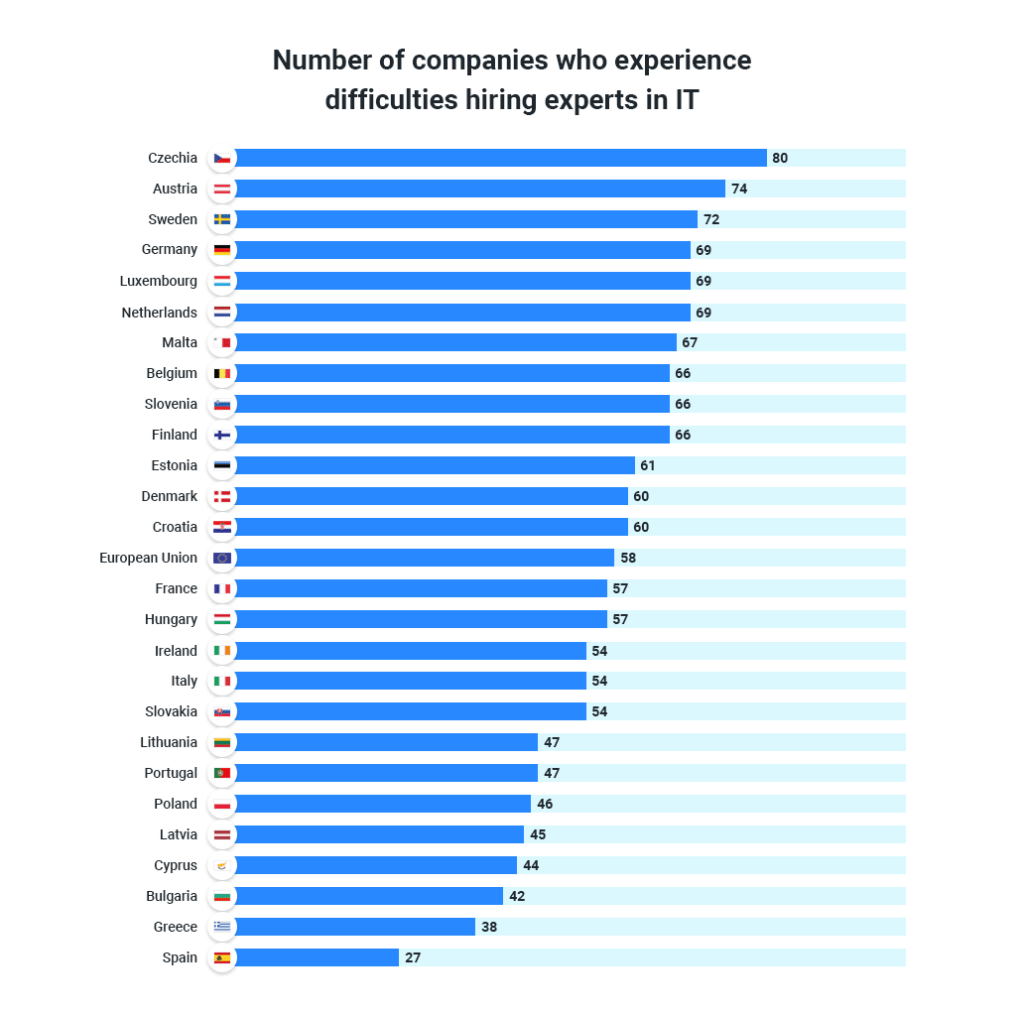Case Study: How Europe May Profit From IT Nearshoring

IT nearshoring has become more and more popular nowadays. And that’s not without a reason. Rapid technology development and increasing demand for qualified workers pose challenges for companies in filling their vacancies with suitable local candidates. It is especially valid for computer science and fields adjacent to it, e.g communication technologies.
According to the statistics, the number of companies who experience difficulties hiring experts in IT reaches up to 74% in some of the state members of the European Union (Sweden). On average, the numbers are smaller, around 50%, which means that half of the companies with job openings encountered issues with filling vacancies.

Hiring entry-level specialists is a bit easier due to the popularity of the IT sphere. However, when it comes to senior specialists, including project and tech leaders, developers and architects are much harder to find.
The possible reasons for such tendencies in market development are complex. The main one is that human resources cannot cover the rising demand due to the time necessary to acquire proficiency. In addition, highly skilled specialists migrate to different countries.
Also, with the possibility of changing work places easily, staff turnover rates increase. It may take several months to fill required vacancies if a company is focused only on local candidates, as due to these shortages the high-level specialists are not likely to change their workplace. After finding such specialists, companies are doing everything possible to keep the specialist with the business longer. But often the deadlines for filling the position are tough. Under such conditions, companies don’t have much time to wait for a local candidate. Once a business finds itself in such a situation, here’s where the nearshoring can come to the rescue.
What is nearshore software development?
The majority of people heard about staff offshoring. In a nutshell, it means delegating some business processes to distant countries to receive better quality with fewer investments. Nearshoring uses the same principle, enabling companies to receive skilled staff members but with the only difference in the location; for instance, if the company is located in the US, the offshoring resources may situate in Asia.
With nearshoring, operations are outsourced to countries with close proximity. In its turn, this approach has a lot more benefits than outstaffing to a more distant country. The small distance fosters personal contact because of the traveling costs.
Another important benefit is the similar cultural backgrounds. Neighboring countries often share similar views and traditions. These points make the communication smooth and allow them to avoid confusion that occurs due to cultural differences. Even if there is more distance between the countries, it’s still possible to understand one another without any difficulties.
One more good thing is language. Even if the states’ languages are different, they are more likely to have specialists who speak the clients’ language, thus, ensuring a higher level of communication. These three factors: geography, culture, and language on the one hand and lower wages on the other, give nearshoring the privilege.
EU profit from nearshore software development
The current situation in the EU job market and the increasing amount of hard-to-fill vacancies are pressing. At the same time, Eastern European countries, such as Ukraine, are a great place to offer nearshore development services. Solid skills, reliability and market reputation make more and more companies hire software developers in Ukraine. Apart from the highly qualified services, nearshoring to Ukraine makes it easier to organize business trips and arrange meetings. This contributes to its market reputation and makes it a perfect nearshore software development in Europe.
Moreover, specialists from developing countries see great value from working experience in global companies, as there are broader career opportunities. When it comes to hiring a nearshore programmer, or even several nearshore developers at once, Ukraine is a great place to look for these specialists. It’s more and more common now to run the project with the nearshore development team.
Concerning average wages, it requires fewer investments into the working labor than in the EU. At the same time, for specialists from nearshore destinations it is beneficial as they receive an opportunity to gain the experience. They receive competitive salaries on the market while staying in their country. Strong skills and commitment levels of Ukraine specialists, as well as business climate, encouraged more than 100 global companies to run R&D offices in Ukraine. Among them Oracle, Magento, Grammarly, Snapchat and other companies providing local developers, engineers and other experts who instill trust.
Our nearshoring experience
While the statistics may speak for themselves, the examples illustrating the real nearshore software development services case studies are better. So, we are sharing our nearshoring success stories.
Сase I
Company: REC
Location: London, UK

Our cooperation started with online communication. The client was interested in hiring remote сontractors for his startup. It was focused on identifying users’ needs to help them choose the best devices and services. With the help of artificial intelligence, smart filtration algorithm offered the best choices analyzing the received answers.
During the first call, we discussed the project vision. We also managed to get acquainted with the client and his ideas. Taking into account the close distance between the countries, the client managed to arrange a visit to our office in Lviv. Here, he was able to get acquainted with our processes from the inside. It helped us to conduct the initial stage of defining business requirements to ensure that every nuance was taken into account. Direct communication helped us to speed up the decision-making process.
Once the first round of business was conducted, we agreed on the definition of done, deadlines and payment method. The client prepared the contract, and we got straight down to business. Also, the decision was to outsource the development while database management was conducted by local partners. The project team consisted of a project manager, a senior developer, a designer and a front-end developer.
At the end phase, the QA engineers were involved. It was done to ensure the correspondence to all the requirements and quality of the end-product. Starting from the first communication attempts to the release date, it took 6 months for all the project stages and delivery.
Taking into account the requirements, a similar project in the UK could take the same or longer time period. It would also depend on the teams’ availability. Thus, the client managed to receive highly qualified service, save time and invest less in the development team. At the same time, we got an advantage, too, receiving valuable experience and a satisfied client.
Case 2
Company: Still Active
Location: Switzerland

The client submitted the application form on our website. He was looking for a WordPress developer. On the next day, after receiving the application, we held a meeting where we discussed the details. The client’s project was aimed at creating a web solution for elderly people. It was focused on boosting an active lifestyle and finding friends that share similar interests on a subscription basis. The search for the appropriate senior WordPress candidate took us 2 days to pass the technical tests and the interview.
After the first stage was passed, we had a technical interview with the client. It was done within 3 days after submitting the form. The client was considering several companies that offered remote and extended teams. But finally, our candidate was chosen because of our professional ethics and soft skills. Onboarding and requesting all the accesses took one more day. So, in 7 days from the initial contact, the developer started working for the client.
From the start of the project, we were supporting the client and the candidate by sharing technical knowledge. We also helped in finding the optimal solutions to ensure the success of both parties.
Passing the onboarding in our office, the developer was invited to visit the client. On site, he had a possibility to meet clients in-person for direct communication and team-building. The developer is communicating and reporting directly to the client. And now our role is focused on providing the HR support and conducting regular performance reviews per the client request. In that manner, we can ensure that the service is provided at the highest level. We also ensure that both parties are satisfied with the job they do.
These are only two of our stories that brought value to the business of our customers. They can be taken as samples to estimate the project duration.
But regardless of the complexity levels, we can ensure the highest proficiency level of the specialists and teams we provide. We also develop detailed business process plans and are ready to discuss business trips to clients’ offices. Besides, we leverage all the power to get the specialists within the shortest time periods depending on the requirements. And, last but not least, to increase the number of happy clients!





Comments (7)